Content pillars are essential for structuring and guiding your social media strategy, ensuring consistency and relevance. Keeping these pillars aligned with your brand goals is vital as digital trends shift.
This article explores the importance of social media content pillars in the context of AI social media analysis tools and social media analytics, which will help you refine and optimize your approach. With these actionable insights, you’ll be better equipped to create content that resonates and drives engagement across your social media channels.
Let’s dive in!
Key takeaways
-
Content pillars are strategic themes that serve as the foundation of your social media strategy, ensuring consistency and alignment with brand goals
-
They help streamline content creation, maintain brand voice, create value-driven content, and build long-term sustainable strategies
-
To create effective content pillars: understand your audience deeply, know your business strengths, analyze competitors, brainstorm key themes, define subtopics, align with your marketing funnel, create varied content, track performance metrics, and communicate results across teams
-
Content pillars should encompass different content formats (short-form and long-form) and guide your content calendar organization
-
Industry examples include travel inspiration and safety updates for airlines, product showcases and maintenance tips for automotive, tutorials and sustainability for beauty brands, student achievements and educational resources for education, and workout routines and nutrition advice for health/fitness
-
Performance tracking through tagging, grouping, and analytics tools helps identify successful patterns and underperforming areas for continuous optimization
-
Content pillars provide structure for diversified content while maintaining brand consistency, leading to better engagement, higher visibility, and stronger audience connections
-
AI analysis tools can help refine and optimize content pillar strategies by providing actionable insights for sustained social media growth
What are content pillars for social media?
Content pillars are the strategic themes or topics that serve as the foundation of your social media content strategy. Think of them as the main categories that align with your brand’s values, goals, and audience interests.
By defining clear content pillars, you create a structured approach to content creation, minimizing repetitive content and ensuring consistency and relevance across all your social media channels.
These pillars guide what types of content to produce and help in organizing your content calendar, and maintaining a cohesive brand voice while addressing different aspects of your audience’s needs.
For example, a health and wellness brand might have content pillars such as nutrition, fitness, mental health, and lifestyle tips. Each piece of content then fits within one of these pillars, making it easier to plan, create, and schedule posts that align with your overall strategy.
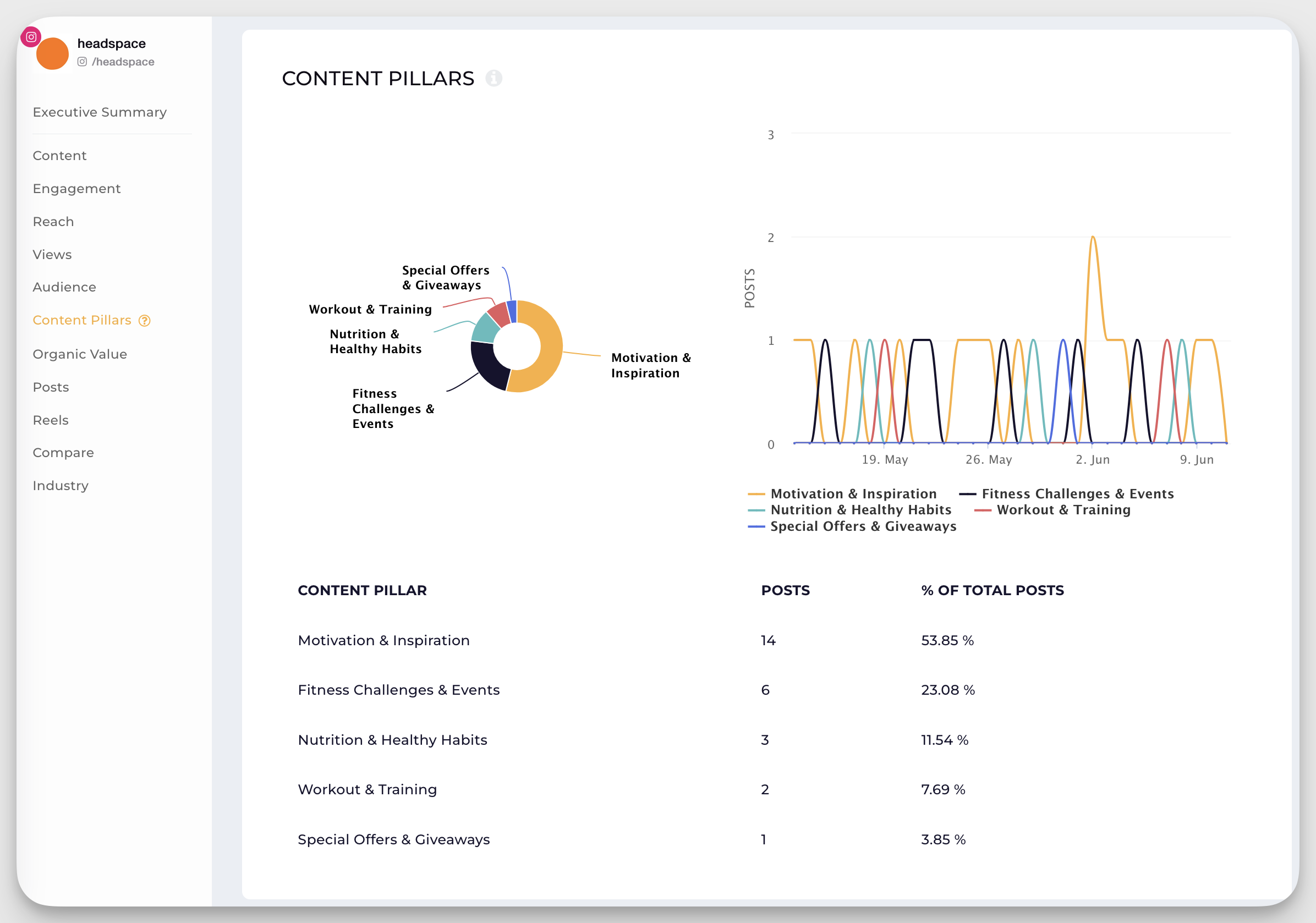
In Headspace’s case, as you can see, their Instagram content is divided into motivational / inspirational posts, challenges, nutrition advice, workout ideas, and giveaways.
In the context of social media, content pillars are particularly powerful because they allow for the diversification of content formats - short-form content like tweets or Instagram stories, long-form content like blog posts or videos, and everything in between. This diversification helps keep your audience engaged while ensuring that every piece of content is purposeful and on-brand.
Furthermore, content pillars help in organizing content calendars, identifying content gaps, and ensuring that the content resonates with your target audience.
By categorizing your content into these key themes, you can craft a more targeted and effective social media strategy, leading to better engagement, higher visibility, and a stronger connection with your audience.
Victor Mukubvu, Digital Marketing Analyst at Mitsubishi Electric, enjoys using Socialinsider’s feature for tagging and grouping social media posts by hashtags or keywords:
"The option to tag and group social media posts has been the main feature I’ve used." - Victor Mukubvu, Digital Marketing Analyst at Mitsubishi Electric
Why are social media content pillars so important?
Social media content pillars are crucial because they are the base of your brand consistency through messaging that remains consistent and cohesive across all platforms. Additionally, they provide a structured approach to content creation, making it easier to plan, execute, and engage your audience effectively.
Implement a structured content plan
Creating a structured content plan around your social media content pillars allows for better organization and consistency.
By categorizing content under specific themes, you can streamline your content creation process, ensuring that each piece aligns with your brand’s goals and resonates with your target audience. This approach not only simplifies content scheduling but also helps in maintaining a steady flow of relevant and engaging content across all social media channels.
Have the same brand voice and messaging
Aligning your social media content with well-defined pillars helps maintain a consistent brand voice and messaging across all platforms.
This consistency reinforces your brand identity, and by planning through a content calendar, it becomes easier for your audience to recognize and connect with your content. By sticking to your core themes, you make sure that every piece of content supports your brand’s mission and values, creating a cohesive and unified presence that resonates with your followers.
Create value-driven content
Focusing on value-driven content ensures that everything you share is relevant content for your target audience; your content is informative and beneficial.
By anchoring your content around well-defined pillars and incorporating keywords relevant to your content, you consistently provide your followers with information that meets their needs and interests.
This approach not only strengthens your relationship with your audience but also positions your brand as a trusted source of valuable insights, encouraging higher engagement and fostering long-term loyalty.
Streamline your content creation process
By organizing your content around specific pillars or content buckets, you can streamline your content creation process, making it more efficient and focused.
This structure allows you to plan and produce content more systematically, reducing the time spent on brainstorming and ensuring that every piece contributes to the diversity of your content while aligning with your overall strategy. It also helps in maintaining a consistent posting schedule, which is crucial for keeping your audience engaged and growing your social media presence effectively.
Consistently using content pillars helps reinforce your brand identity, as you build your content around them, ensuring that every piece aligns with your core values and messaging.
Over time, this repetition and consistency build a strong, recognizable brand presence that resonates with your audience. By sticking to your defined themes, you create a cohesive narrative that strengthens your brand’s image, making it more memorable and trustworthy in the eyes of your followers.
Build a long-term strategy
Content pillars or content buckets provide a strong foundation for developing a long-term social media strategy. By focusing on core themes, you ensure that your content remains relevant content for your target audience, aligned with your brand’s goals, and always aims at creating content your audience will love.
This approach allows you to build a consistent narrative, adapt to changes in the market, and sustain your brand’s presence across various social media platforms.
With a long-term strategy, you can more effectively track progress, measure success, and make informed adjustments to continually improve your content efforts.
How to create content pillars for social media
To build a cohesive and effective content strategy, it’s essential to carefully craft your content pillars to align with your brand’s goals and audience interests. By defining these pillars, you can categorize content effectively to ensure that your social media posts remain consistent with your brand’s goals and that your content resonates with your target audience.
Here are 9 steps you need to follow to create content pillars for social media:
1. Start with a deep understanding of your customers’ needs and social media personas
2. Know your business strategy strengths
3. Analyze your competitors’ content performance
4. Brainstorm and group key themes into strategic content categories
5. Define your content pillars with sub-topics
6. Align each content pillar with your marketing funnel
7. Create content for each content pillar
8. Track social media content pillars’ performance metrics
9. Communicate content pillars performance across teams
#1. Start with a deep understanding of your customers’ needs and social media personas
To create effective content pillars, start by thoroughly understanding your audience’s needs and social media personas, and use a content pillar template to organize these insights effectively.
This involves researching their demographics, behaviors, preferences, and pain points to craft content that truly resonates with them. By aligning your pillars with these insights, you establish that your content addresses the specific interests and challenges of your target audience, making it more engaging and impactful.
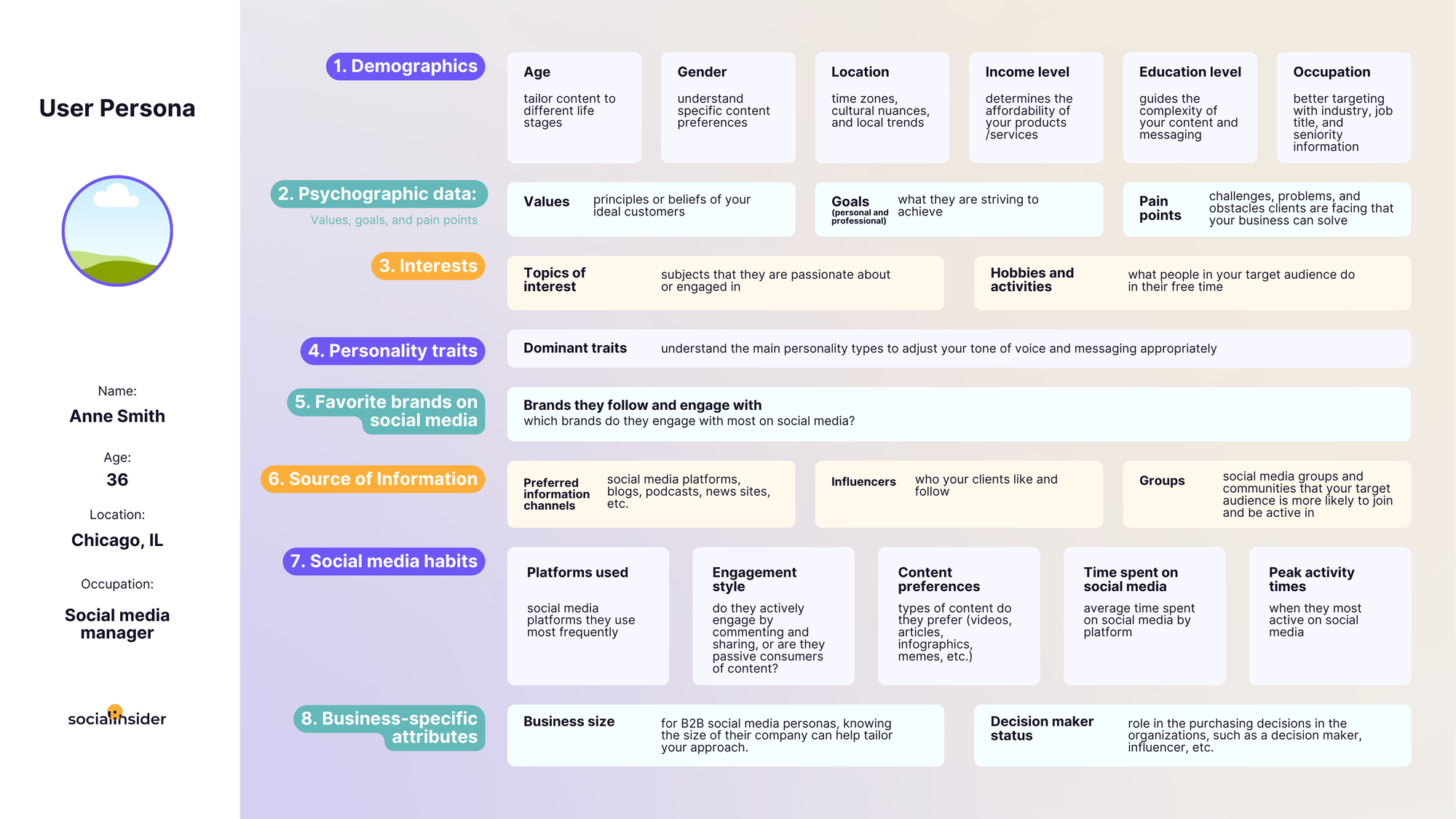
#2. Know your business strategy strengths
Understanding your key differentiators is crucial for shaping your social media content pillars. These strengths, such as unique products, services, or expertise, should be prominently featured in your communication strategy.
For instance, at Socialinsider, our original research and studies are a significant differentiator, helping us rank first in Google searches for social media benchmarks. By highlighting these strengths in your content pillars, you reinforce what sets your brand apart and build a stronger, more compelling presence on social media.
#3. Analyze your competitors’ content performance
To refine your content pillars, it’s essential to analyze how your competitors are performing in similar areas. Within the Socialinsider platform, you can do so by grouping and tagging their social media posts according to content pillars.
By searching for specific keywords and categorizing content into “buckets”, you gain valuable insights into what works for your competitors. This analysis helps you identify gaps, opportunities, and successful strategies, allowing you to tweak your content pillars for better alignment with market trends and competitor activities.

#4. Brainstorm and group key themes into strategic content categories
Start by identifying key themes to develop content pillars that align with your brand values and resonate with your audience’s interests. These themes should reflect what your brand stands for and what your audience cares about.
Once you’ve brainstormed these themes, group them into broad content pillars that allow you to categorize content effectively and maintain a cohesive strategy. This approach allows you to organize your content effectively, ensuring that each piece fits within a larger, cohesive strategy. By categorizing your content this way, you can maintain consistency and relevance across all your social media channels.

#5. Define your content pillars with subtopics
Consider using a content pillar template to break them down into specific subtopics. Each of your broad content pillars should encompass a range of related subtopics or individual content pieces that help diversify your content while maintaining a coherent narrative.
This approach allows you to delve deeper into each pillar, offering varied yet connected content that keeps your audience engaged. By organizing your content this way, you can establish that each post contributes to a broader, well-rounded strategy.
#6. Align each content pillar with your marketing funnel
Align each content bucket with specific stages of your marketing funnel—awareness, consideration, and decision. By attaching a clear goal to each pillar, you ensure that your content guides potential customers through their journey with your brand.
For example, in the awareness stage, focus on educational content that introduces your brand, while in the decision stage, highlight testimonials or product features. This strategic alignment helps create a more cohesive and effective content strategy that drives conversions.
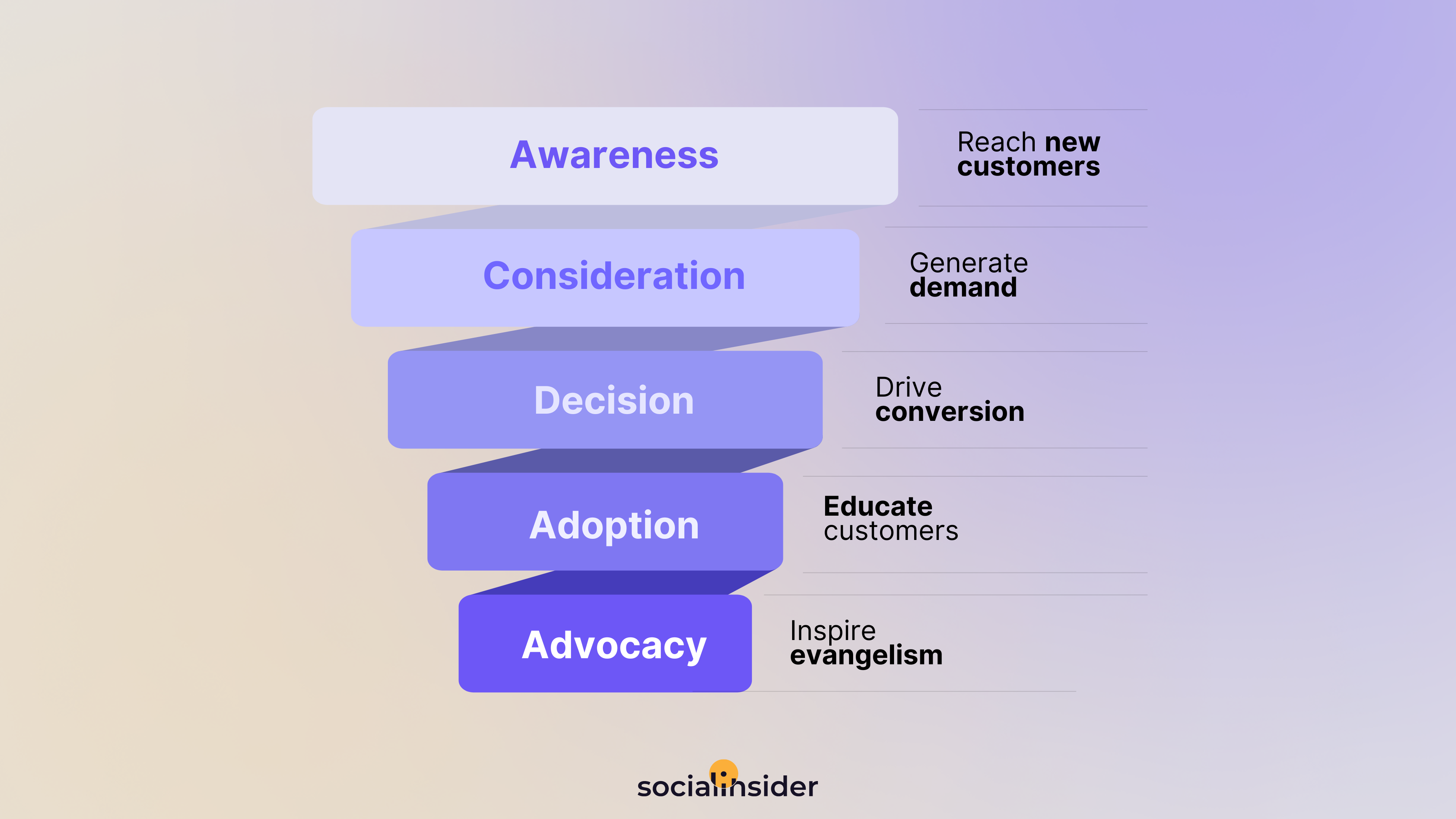
#7. Create content for each content pillar
Once you craft your content pillars, it’s time to start creating relevant content for your target audience that aligns with each one, ensuring consistency and relevance.
Develop a mix of content types - such as short-form content like social media updates and stories, as well as long-form content like long text, videos, and infographics - that fit within the themes of your pillars.
Certify that each piece of content not only aligns with the pillar it falls under but also serves the specific goals tied to your marketing funnel. By creating varied and purposeful content, you keep your strategy fresh and engaging while driving your audience toward conversion.
#8. Track social media content pillars’ performance metrics
To effectively analyze your content pillars, Socialinsider offers a robust tagging and grouping feature within your selected project.
After you create content pillars and tag your social media posts accordingly, you can categorize and organize your content within your content calendar, ensuring thematic consistency.

Once tagged, head to the Content Pillars → Content Pillars Benchmarks section.
Here, you’ll find a comparative table displaying engagement metrics for each theme, which currently represents your content pillars, allowing you to closely monitor content analytics and performance. This overview allows you to see how each pillar is performing relative to others, offering valuable insights into which themes are driving the most engagement.

Regularly reviewing these content pillars’ benchmarks and focusing on keywords relevant to your content enables you to identify successful patterns and underperforming areas, allowing you to tweak your content pillars as needed for improved performance. If a particular pillar excels, you can double down on similar content. If a pillar lags, experimenting with different content types or messaging may help boost your content’s effectiveness.
Using Socialinsider, you can continuously refine your content strategy, ensuring each pillar aligns with your overall marketing goals and maximizes engagement across your social media platforms.
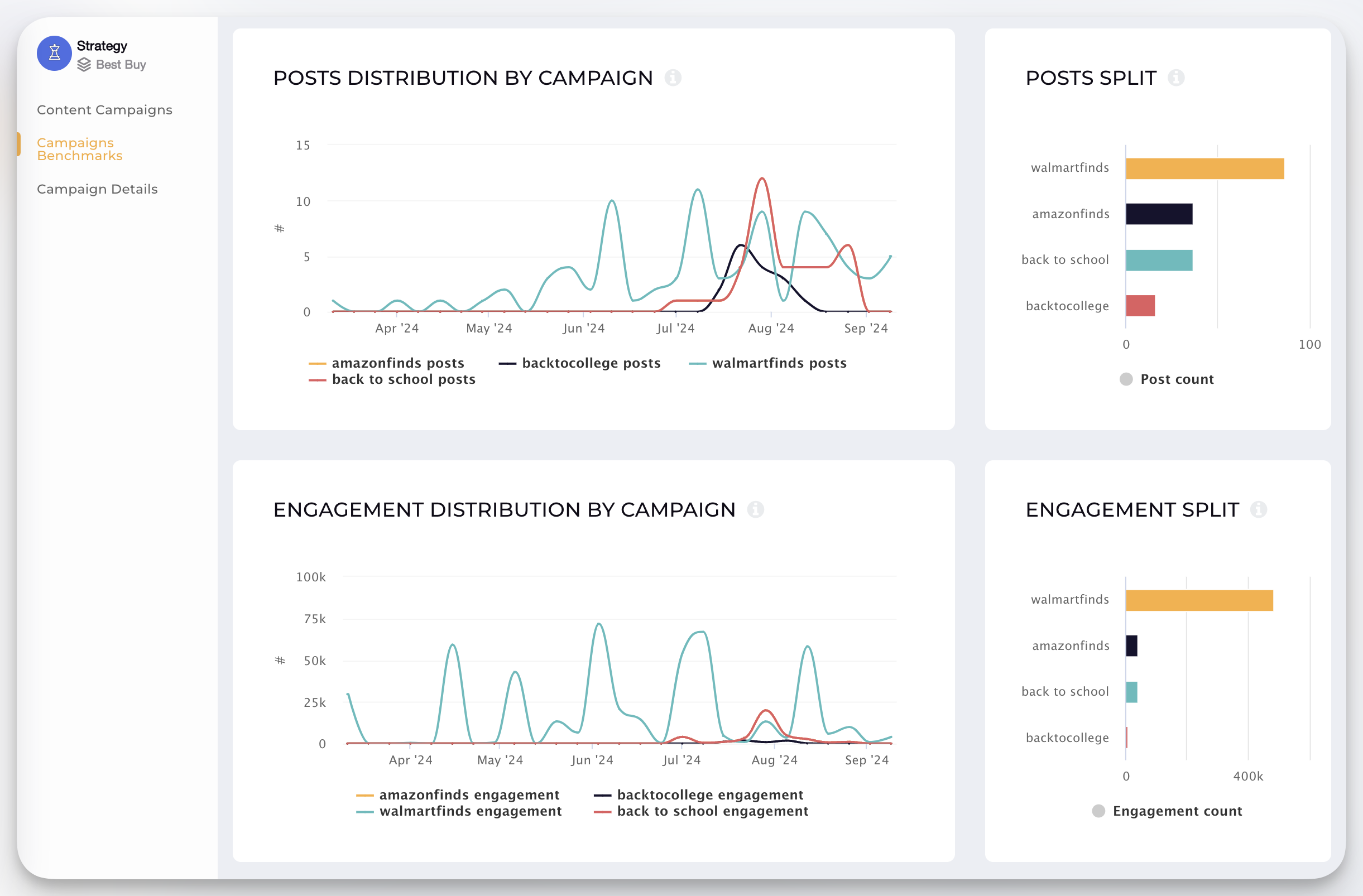
Measure your content pillars with Socialinsider
Analyze your social media content performance across channels and compare it against top competitors.
Start a 14-day FREE trial#9. Communicate content pillars’ performance across teams
After you create content pillars, effectively communicating their performance across all teams is crucial for maximizing their impact on your business. When a particular content pillar performs exceptionally well, sharing this success across teams can also highlight how enhancing the diversity of your content can better support overall business goals.
For instance, high-performing content pillars can influence social media marketing campaigns, inform product development, and shape sales strategies, ensuring that the entire organization benefits from the insights gained and drives cohesive growth.
Social media content pillars examples for 7 industries
To inspire your content strategy, we’ve developed examples of content pillars for seven key industries.
These industries were chosen based on the most frequent inquiries we’ve received, providing tailored insights that can help you refine your social media strategy and better engage your audience.
Each example is designed to highlight how specific content pillars can drive success in your industry.
Social media content pillars examples for the Airline industry
The Airline industry presents unique opportunities and challenges for engaging with customers on social media. To help you craft a compelling strategy, we’ve identified key content pillars tailored specifically for airlines.
These pillars focus on enhancing customer experience, showcasing destinations, promoting deals, and more, ensuring your content resonates with both frequent flyers and potential travelers. These examples will inspire and guide you as you craft your content pillars, helping you build stronger connections with your audience.
Travel inspiration
Inspire your audience as part of your brand’s social media content strategy by sharing breathtaking visuals and compelling stories of destinations around the world.
Use high-quality images and videos to transport your followers to exotic locales, encouraging them to consider your airline for their next adventure.
Highlight unique travel experiences, such as hidden gems or off-the-beaten-path destinations, to differentiate your brand and keep your content fresh and exciting.
To make your travel inspiration posts more engaging, consider incorporating travel tips or fun facts about each destination.
Use captions that spark curiosity and include calls to action, inviting your audience to share their travel dreams or experiences. This not only drives engagement but also builds a community of travel enthusiasts around your brand.

Customer stories & testimonials
Understanding how to create social media content that includes customer stories and testimonials is crucial for building trust and credibility. Share real-life experiences from satisfied customers who have flown with your airline, emphasizing positive aspects such as comfort, service, and convenience. Feature diverse stories that resonate with different segments of your audience, from business travelers to vacationing families.
Include quotes, photos, or short video clips from the customers themselves. Encourage your followers to submit their testimonials or tag your airline in their travel posts for a chance to be featured. This not only provides authentic content but also strengthens the connection between your brand and your audience.
Behind-the-scenes
Identify keywords relevant to behind-the-scenes content, and find common themes in your content that humanize your brand and build transparency.
Share glimpses of what happens behind the curtains, such as aircraft maintenance, crew preparations, or even the process of creating in-flight meals. This content not only satisfies curiosity but also builds trust by showing the care and effort that goes into every flight.

To enhance the appeal of behind-the-scenes content, consider using time-lapse videos or live streaming to showcase real-time activities. This approach makes the content more dynamic and engaging, allowing your audience to feel like insiders. Additionally, use captions or interviews with staff members to provide context and add a personal touch.
Safety & security updates
Keeping your audience informed about safety and security updates is crucial for maintaining trust and confidence in your airline. Regularly share posts that detail new safety protocols, updates on travel restrictions, or improvements in security measures. This content reassures passengers that their well-being is your top priority.
When crafting these posts, aim for clarity and conciseness. Use infographics or bullet points to make complex information easier to digest. Additionally, consider creating a dedicated highlight on your social media profiles for ongoing updates, ensuring that this important information is always easily accessible to your followers.
Promotions & offers
Meaningful content can include promotions and offers, which are key to attracting new customers and retaining loyal ones. Regularly post about special deals, discounts, and limited-time offers that encourage immediate bookings. Use eye-catching visuals and compelling copy to highlight the value of these promotions, making them hard to resist.
Segment your audience and tailor offers to specific groups, such as frequent flyers or families planning vacations. Create urgency by emphasizing time-limited deals or exclusive offers for social media followers.

Destination guides & tips
Among the valuable content ideas are destination guides and tips, which provide valuable information that enhances your audience’s travel experiences.
Create detailed guides for popular destinations, including must-see attractions, local dining recommendations, and insider tips for a smoother trip. This type of content positions your airline as a helpful resource, encouraging travelers to choose your brand.
Incorporate UGC (user-generated content), such as photos or reviews from passengers who have visited the destination. You can also create downloadable PDFs or save these guides as highlights on your social media profiles, making them easy to reference for your followers planning their trips.
Sustainability initiatives
Highlighting your airline’s sustainability initiatives can resonate strongly with environmentally conscious travelers.
Share content about eco-friendly practices, such as reducing carbon emissions, using sustainable materials, or participating in carbon offset programs. This positions your airline as a responsible brand that prioritizes the environment.
To further engage your audience, consider creating educational posts that explain the impact of your sustainability efforts. Use infographics or short videos to visualize the positive outcomes of these initiatives.
Encourage your audience to participate by offering tips on how they can reduce their carbon footprint when flying, fostering a community of eco-aware travelers.
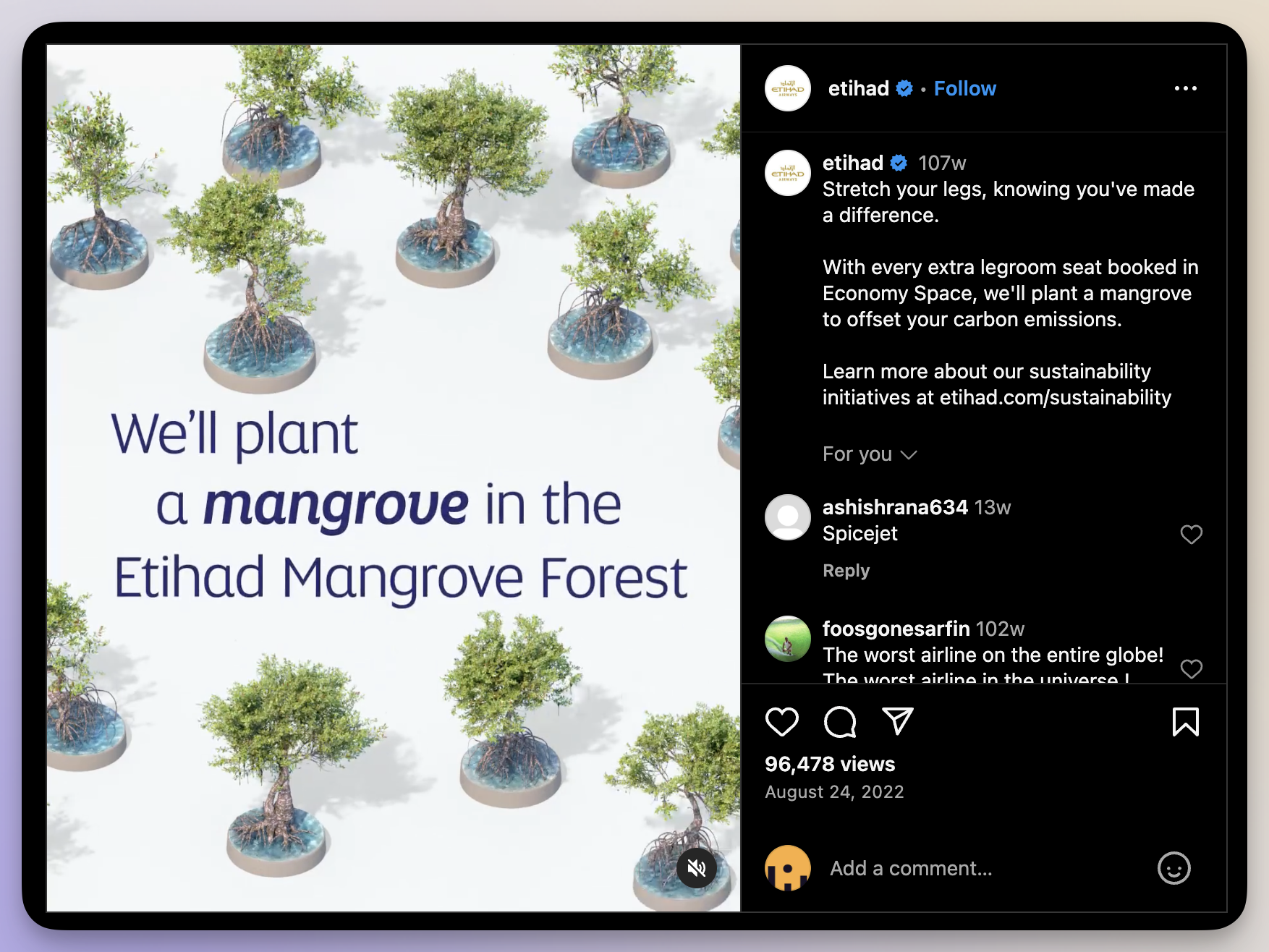
Industry news & updates
Use social media measurement to track how effectively industry news and updates position your brand as a leader in the aviation field. Share relevant news about innovations in aviation technology, regulatory changes, or global travel trends that impact your customers. This not only educates your audience but also demonstrates your airline’s commitment to staying ahead in the industry.
Add expert commentary or insights from your airline’s leadership. This can provide added value by helping your audience understand the implications of the news. Create polls or Q&A sessions around industry updates to encourage interaction and gather feedback from your followers.
Employee spotlights
Featuring employee spotlights is a great way to personalize your brand and connect with your audience on a human level.
Share stories, interviews, or day-in-the-life posts of various team members, from pilots and flight attendants to ground crew and customer service representatives. This content helps humanize your airline and showcases the people who make every flight possible.
Use fun facts or little-known details about each employee’s role or journey in the airline industry. Encourage your employees to share their experiences and thoughts directly with your audience through short video clips or written testimonials.
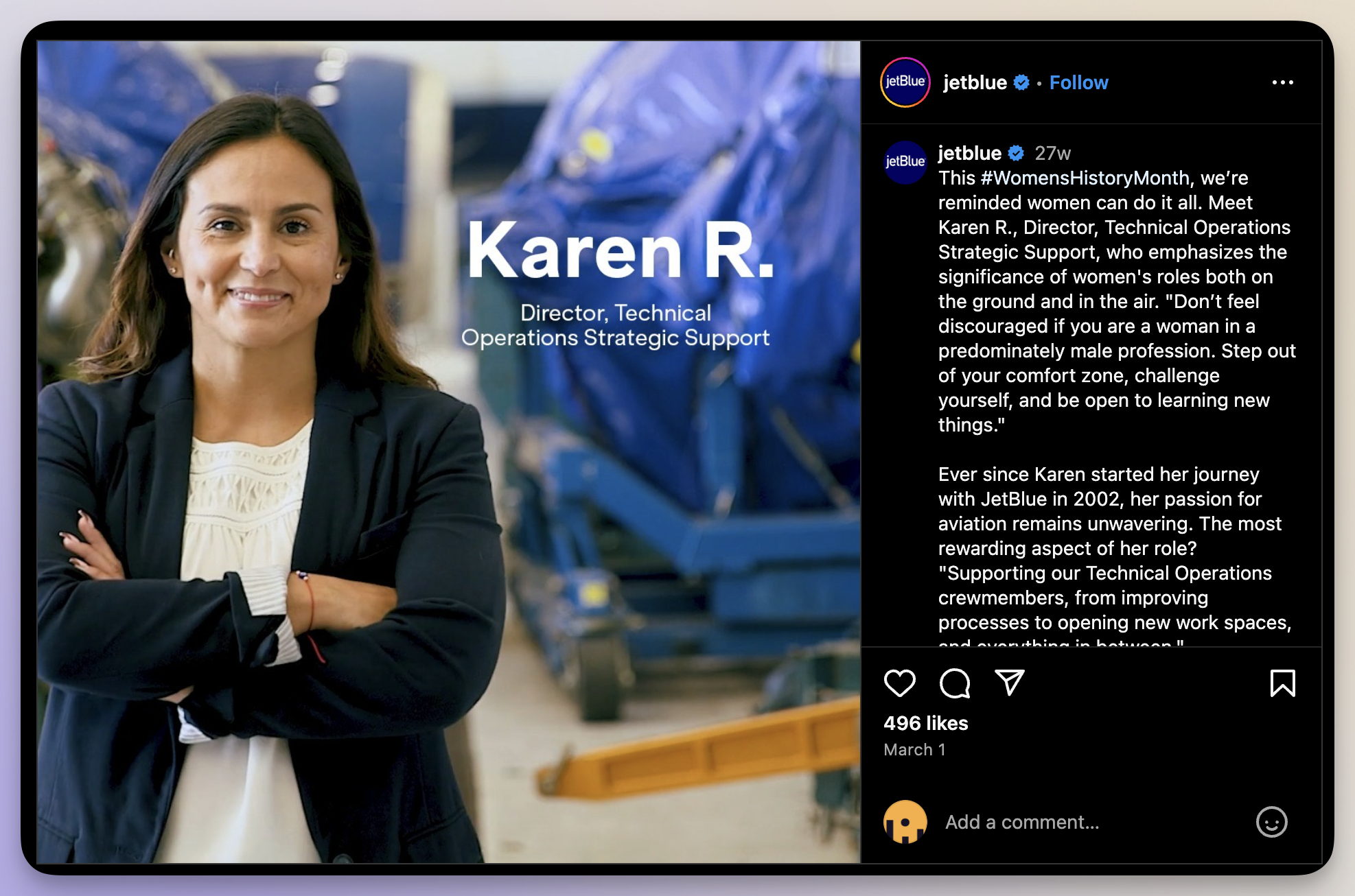
Interactive content & contests
Interactive content and contests are excellent ways to boost engagement and create a lively community around your brand. Host polls, quizzes, or contests that encourage your audience to participate, such as photo contests where followers share their best travel pictures for a chance to win flight vouchers. This type of content not only drives interaction but also generates user-generated content that you can feature on your channels.
When organizing contests, make sure to clearly outline the rules and prizes, and create excitement by sharing countdowns or reminders.
Social media content pillars examples for the Automotive industry
The automotive industry can engage audiences by focusing on key themes that resonate with car enthusiasts and everyday drivers alike. From showcasing new models to sharing customer stories, these content pillars serve as the foundation of the content strategy, helping automotive brands connect meaningfully with their audience and drive brand loyalty.
Vehicle showcases & reviews
Engage your audience by highlighting new vehicle models and offering in-depth reviews. Use high-quality visuals and videos to showcase the features, performance, and design of your vehicles. This content not only builds excitement around new releases but also helps potential buyers make informed decisions.
Include expert opinions or customer testimonials within the reviews. Offering a balanced perspective that highlights both strengths and areas of improvement can build trust and encourage followers to explore more about the featured vehicles.
Maintenance tips & how-to guides
Educate your audience by providing practical maintenance tips and how-to guides that help them keep their vehicles in excellent condition. Content on routine car care, such as oil changes, tire maintenance, and seasonal checks, positions your brand as a trusted resource.
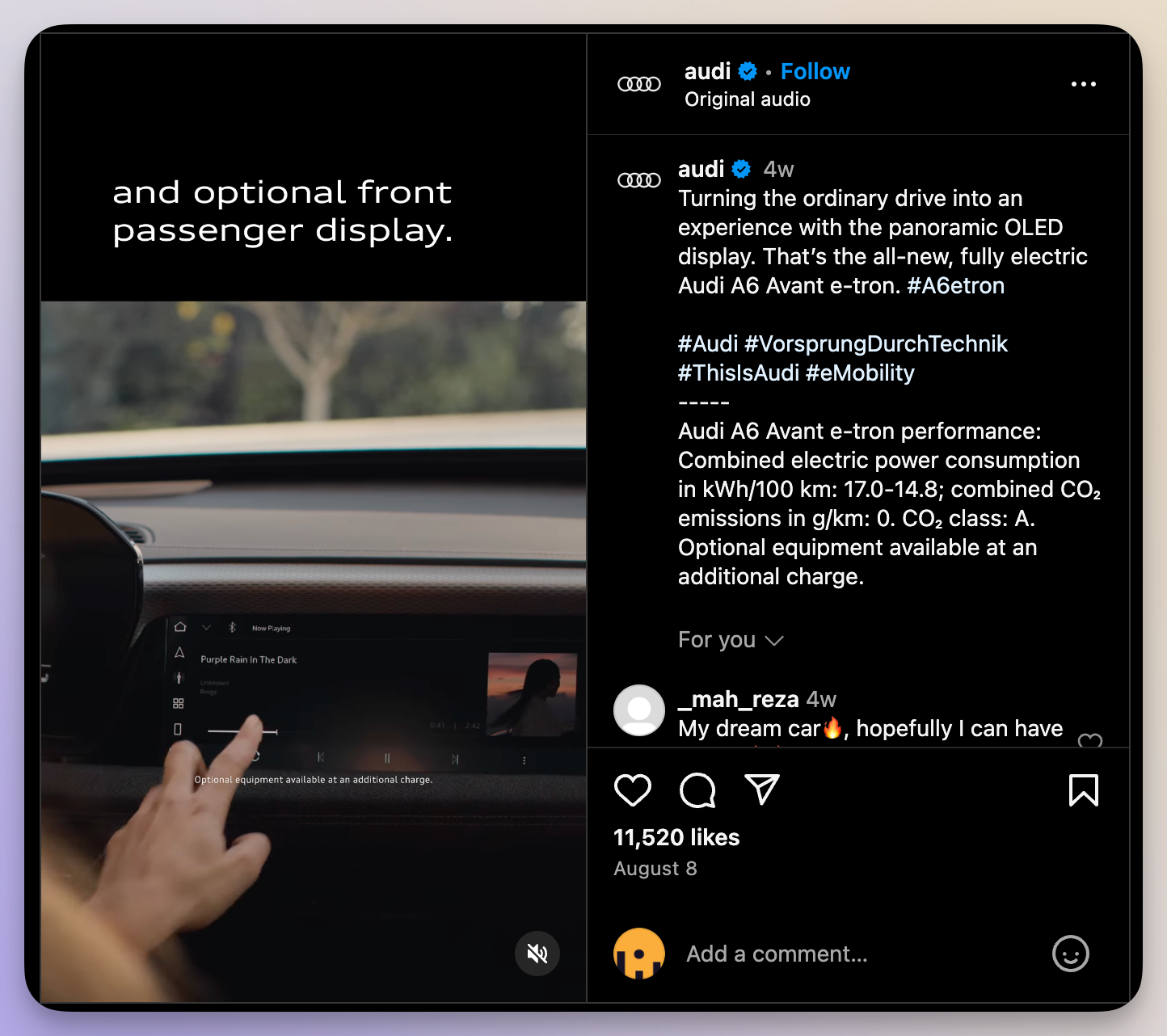
Customer testimonials & stories
Highlighting real-life experiences, satisfaction, and the impact of your vehicles on customers’ lives can make your brand more relatable and trustworthy.
Consider creating video testimonials where customers share their stories in their own words. Incorporating these stories into a broader narrative about your brand’s commitment to quality and customer satisfaction can strengthen your overall messaging and appeal.
Industry news & trends
Create content for social media that keeps your audience informed with the latest industry news and trends, such as innovations in automotive technology, market shifts, or new regulations. Sharing this information positions your brand as an industry leader and helps your followers stay updated on important developments.

Special offers & promotions
Special deals, discounts, and limited-time offers are types of social media content that drive immediate action and attract both new and returning customers. Use visually appealing graphics and clear, persuasive language to highlight the benefits and urgency of these promotions.
To enhance the effectiveness of these posts, segment your audience to tailor offers specifically for them, such as first-time buyers or loyal customers.
Behind-the-scenes content
Offer a behind-the-scenes look at your company’s operations, from vehicle design to production. This content can humanize your brand and build a deeper connection with your audience by showcasing the craftsmanship, technology, and people involved in bringing your vehicles to life.
Use time-lapse videos or interviews with key team members to add a personal touch. Highlighting unique or innovative aspects of your processes can also intrigue your audience and foster greater interest in your brand.

Driving tips & safety advice
Social media insights can guide you in providing the most relevant driving tips and safety advice that your audience can apply in their daily lives. Topics like defensive driving, preparing for long trips, and handling different road conditions can position your brand as a helpful and caring resource.
Create checklists or short videos that explain safety practices clearly and concisely. Encouraging your audience to share their own safety tips or driving experiences can also foster a community-focused environment on your social media channels.
Events & test drives
Events & test drives make for an exciting type of content pillar. Promote events and test drives to create excitement and give your audience the opportunity to experience your vehicles firsthand. Sharing details about upcoming events, along with highlights from past events, can encourage participation and build a sense of community.
Use live streaming or real-time updates during events to engage those who cannot attend in person, making them feel included in the experience.

Car customization & accessories
Inspire your audience with content focused on car customization and accessories, showcasing how your vehicles can be personalized to meet individual tastes. Highlight different customization options, from aesthetic enhancements to performance upgrades, appealing to those who love making their vehicles unique.
Encourage customers to share photos of their customized vehicles or ask for opinions on potential upgrades. Offering customization guides or spotlighting popular accessories can also help educate your audience and drive interest in your brand’s offerings.
Safety tips & innovations
Create content for social media that highlights your brand’s commitment to safety by sharing tips and innovations related to vehicle safety features.
Discuss the latest safety technologies in your vehicles and provide advice on safe driving practices, reinforcing your brand’s dedication to protecting drivers and passengers.
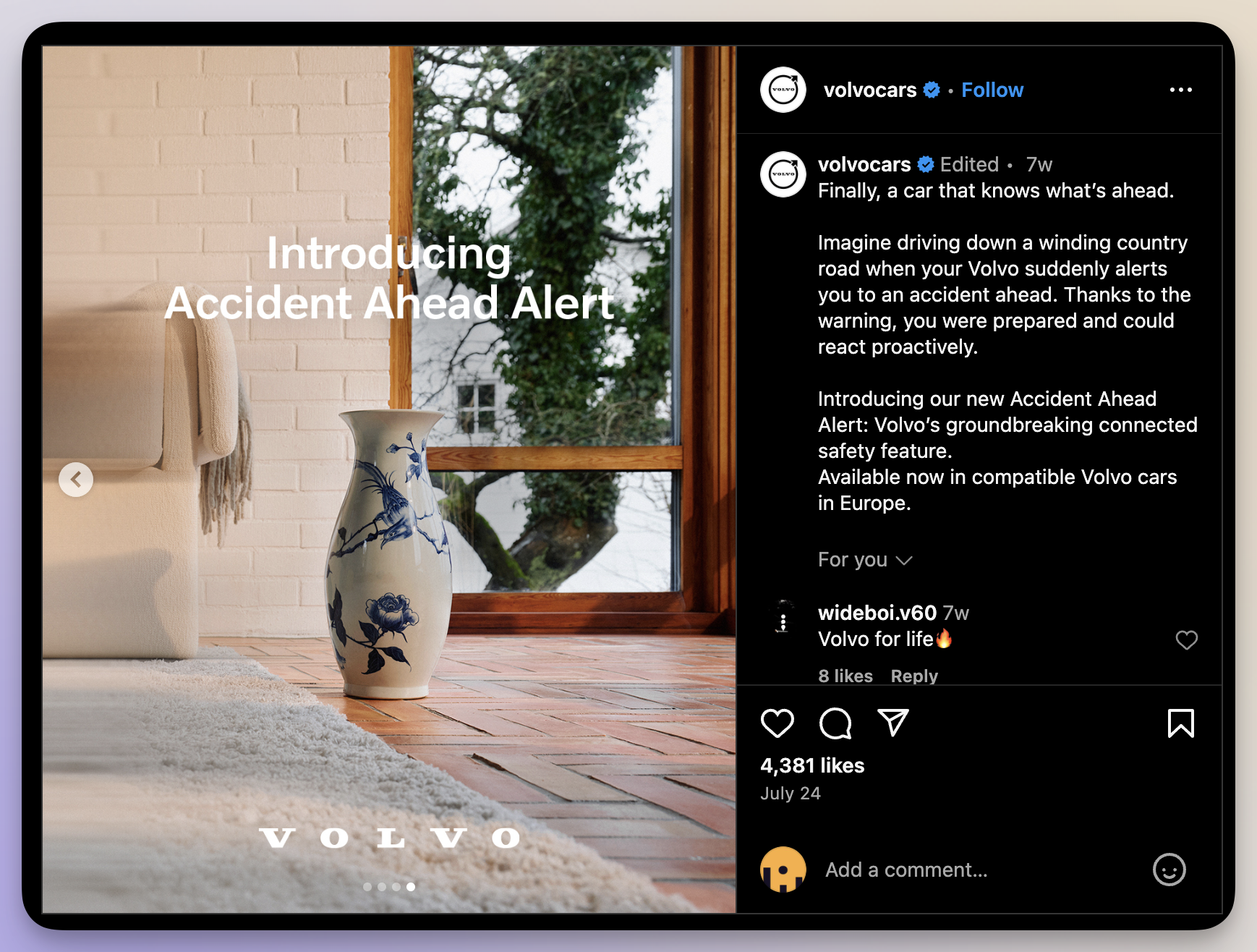
Social media content pillars examples for the Beauty & Cosmetics industry
The beauty and cosmetics industry thrives on creativity and trends, making social media essential for brand growth. We’ve identified key content pillars that focus on product showcases, beauty tips, customer experiences, and more to help you create engaging and visually appealing content that resonates with your audience.
Product launches & promotions
When determining the types of content to post, showcasing product launches and promotions is a powerful way to generate excitement and drive sales. Use eye-catching visuals and compelling messaging to highlight new products or special deals.
Create countdowns leading up to a launch and share behind-the-scenes content to build anticipation.
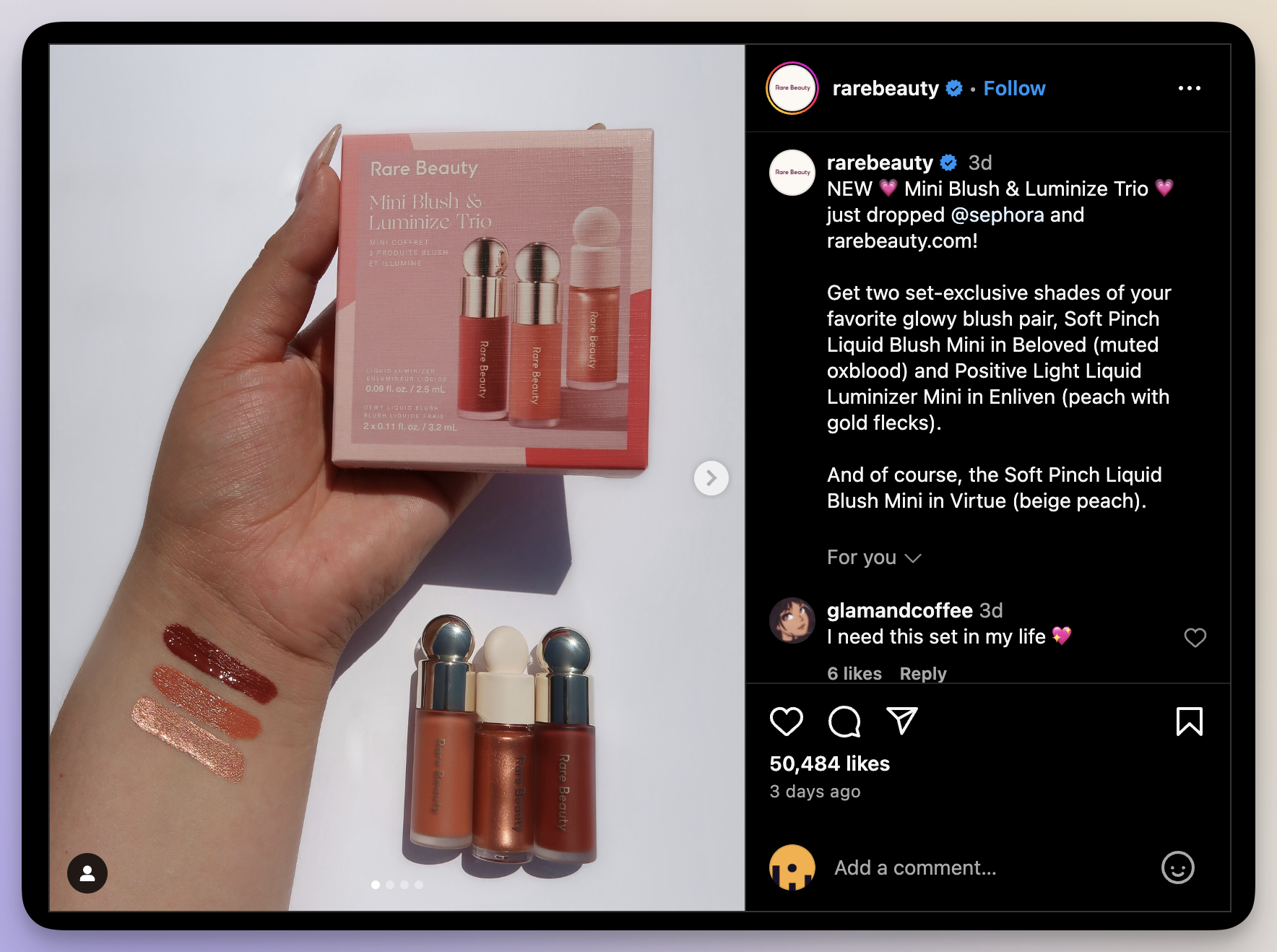
Beauty tips & tutorials
Providing beauty tips and tutorials is a great way to establish your brand as an expert in the industry. Share step-by-step guides for makeup looks, skincare routines, or hair care tips, using videos or infographics to make the content easily digestible.
To enhance the value of your tutorials, collaborate with beauty influencers or industry professionals to offer expert advice. Additionally, encourage user-generated content by asking followers to share their results using your products, creating a sense of community around your brand.
Sustainability & ethics
Highlighting your brand’s commitment to sustainability and ethics is increasingly important in the beauty industry. Share content about your eco-friendly practices, cruelty-free products, and ethical sourcing to connect with socially conscious consumers.
Encouraging your audience to join in by adopting sustainable practices in their beauty routines can also help foster a loyal, values-aligned community.
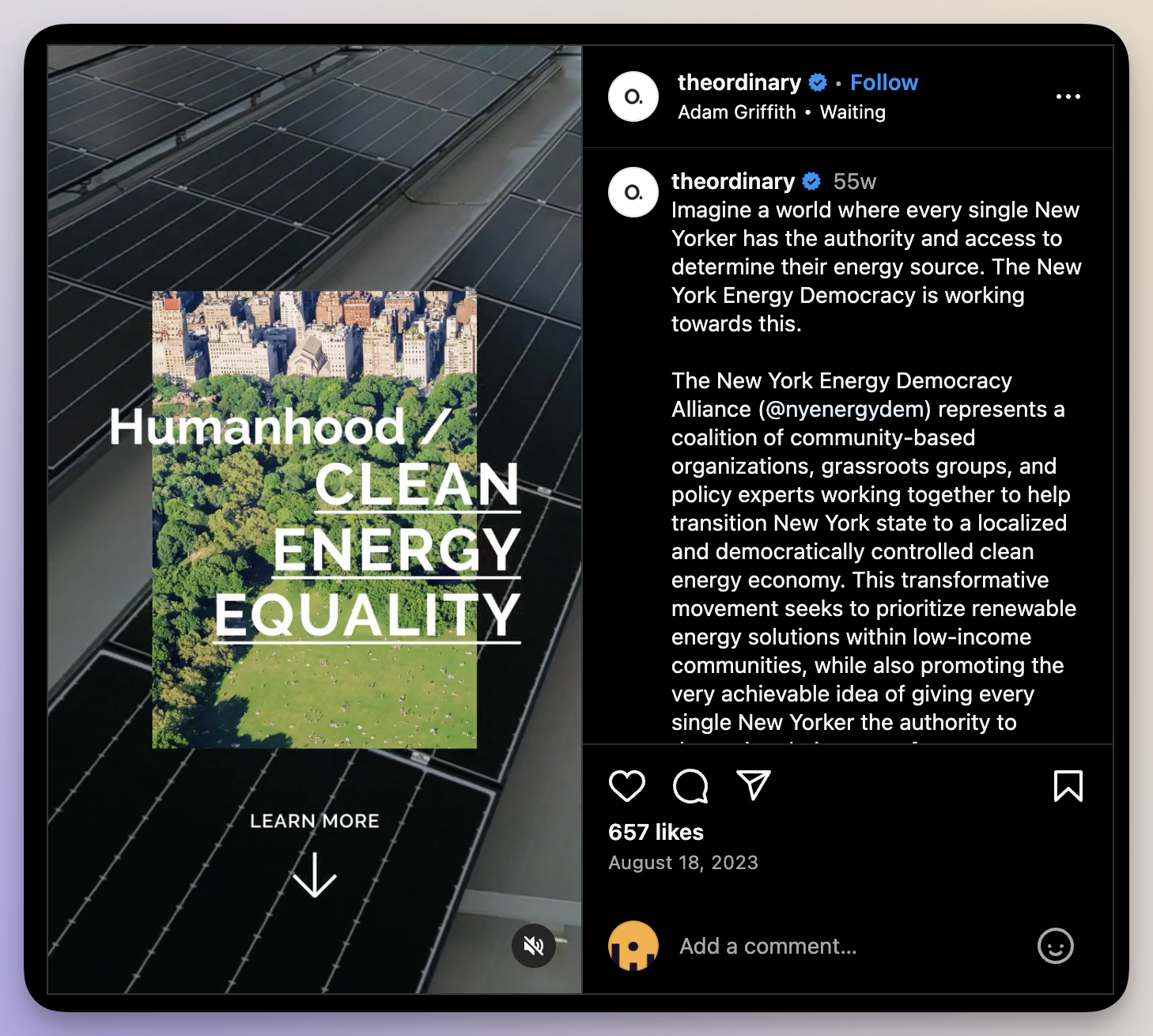
Self-care & wellness
Positioning your brand as a champion of self-care and wellness through content that promotes holistic beauty practices is an example of meaningful content. Discuss the importance of mental and physical well-being, and how your products can contribute to a balanced lifestyle.
For a deeper connection, consider creating content that integrates wellness tips with product recommendations. Hosting virtual self-care sessions or wellness challenges can also engage your audience, encouraging them to prioritize their well-being while incorporating your products into their routines.
Inclusivity & diversity
Emphasizing inclusivity and diversity in your content is crucial for resonating with a broad audience and aligning with your social media goals.
Showcase a range of skin tones, body types, and beauty standards in your campaigns, ensuring that everyone feels represented by your brand.
To further this message, collaborate with diverse influencers and create content that highlights the beauty of different cultures and identities.

Brand story & leadership
Telling your brand’s story and highlighting leadership can help build a deeper connection with your audience. Share the history of your brand, its mission, and the people behind it. Highlight milestones and achievements that showcase your brand’s growth and impact in the industry.
Share personal stories from your founders or key team members, focusing on their passion for the beauty industry. This approach not only humanizes your brand but also builds trust and loyalty by showing the values and vision driving your business.
Seasonal & trend-based beauty
Capitalize on seasonal trends and beauty fads by tailoring your content to what’s currently popular. Create content that aligns with holiday seasons, weather changes, or trending beauty looks, keeping your brand relevant and top-of-mind.
Stay ahead of trends by monitoring industry news and social media buzz. Offering quick tutorials or product recommendations that tie into these trends can help your audience achieve the latest looks while positioning your brand as a trendsetter.

Product range
AI use cases for social media can include automating the showcasing of your full product range, allowing your audience to discover and engage with the breadth of what you offer. Create content that highlights different product categories, such as skincare, makeup, or hair care, and how they can be used together for a complete beauty regimen.
Create bundles or curated sets that highlight complementary products. Offering detailed descriptions, usage tips, and pairing suggestions can help customers make informed decisions and see the value in your entire product lineup.
Behind-the-scenes & brand insights
Offering a behind-the-scenes look into your brand provides transparency and builds trust. Share content that showcases the production process, product development, or day-to-day operations at your company, giving your audience a glimpse into what makes your brand unique.
To deepen the connection, live-stream events like product launches or Q&A sessions with your team. Sharing insights into your brand’s values, challenges, and innovations can further engage your audience and strengthen their loyalty to your brand.

Influencer collaborations
Partnering with influencers can significantly amplify your brand’s reach and credibility. Share content that features influencer collaborations, such as product reviews, tutorials, or sponsored posts, to tap into their follower base and build trust with potential customers.
Choose influencers who align with your brand’s values and target audience. Encourage them to share their authentic experiences with your products, and create interactive campaigns where their followers can engage with your brand directly, such as giveaways or Q&A sessions.
Social media content pillars examples for the Education industry
The education industry on social media can engage students, parents, and educators through strategic content pillars. From showcasing achievements to sharing valuable resources, these pillars serve as the foundation of the content strategy, helping to build a strong, impactful online presence.
Student achievements & alumni stories
Highlighting student achievements and alumni success stories can inspire prospective students and build pride within your community. Share accomplishments such as awards, scholarships, and career milestones to showcase the impact of your educational programs. This content not only motivates current students but also strengthens your institution’s reputation.
Use a mix of video interviews, photos, and written testimonials. Encourage alumni to share their stories and tag your institution on social media, creating a cycle of positive recognition that can attract new students and foster a strong alumni network.
Teacher & staff highlights
Featuring teachers and staff members is meaningful content that humanizes your institution and builds stronger connections with your audience.
Share profiles, interviews, or day-in-the-life posts that highlight their expertise, dedication, and contributions to the school community.
Include personal anecdotes or insights from the featured individuals about their teaching philosophy or memorable experiences. Regularly rotating who is spotlighted guarantees a diverse representation of your team, fostering a sense of inclusivity and appreciation within your community.
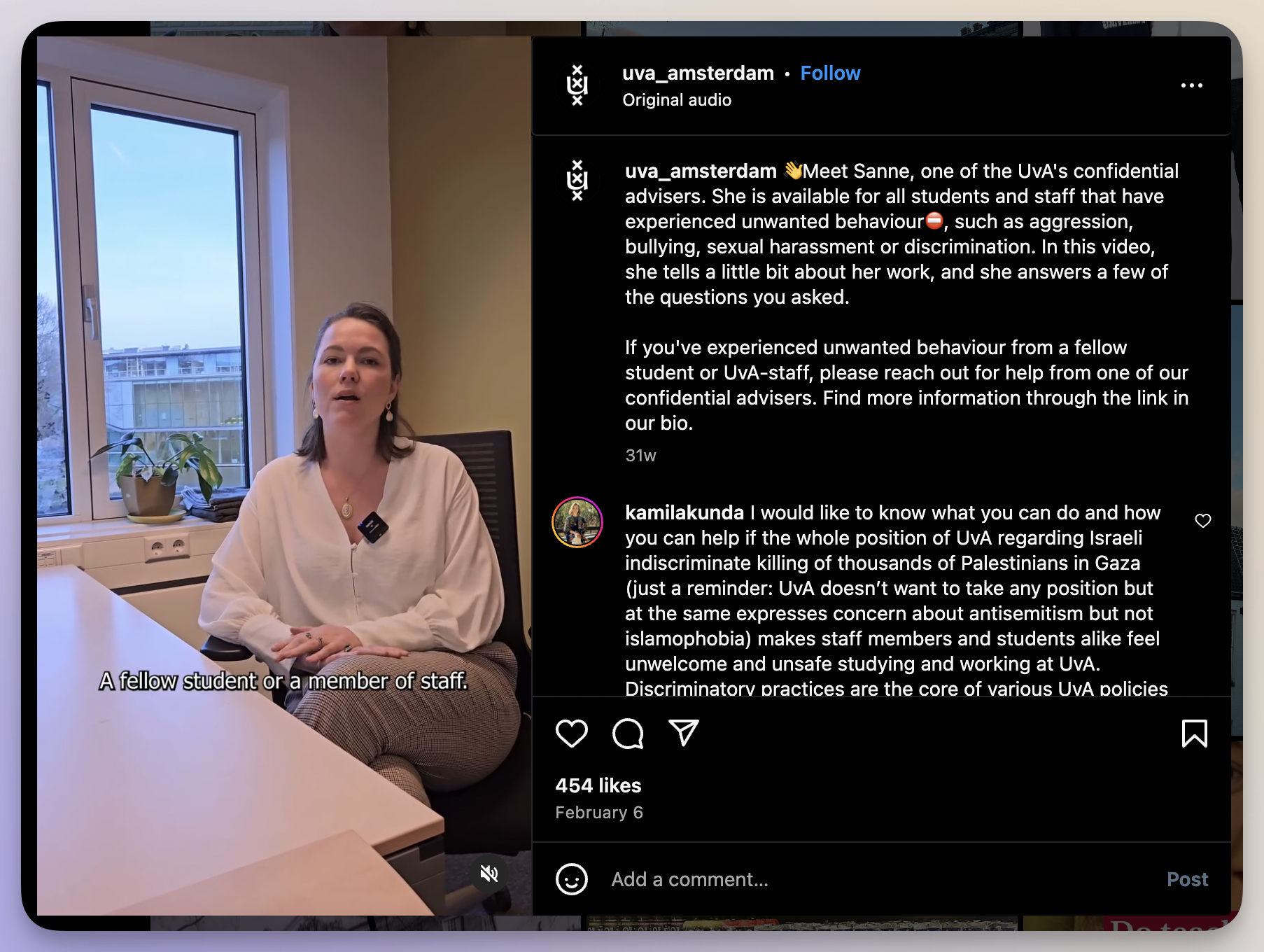
Classroom activities & programs
A social media dashboard can help you track engagement with content showcasing classroom activities and special programs, providing a window into the day-to-day learning experience at your institution. Share content that highlights unique projects, collaborative learning, or special events that reflect your school’s approach to education.
Posting video snippets of these activities can also offer a dynamic view of the learning environment, helping prospective students and parents visualize themselves as part of your school community.
Educational tips & resources
Providing educational tips and resources positions your institution as a valuable source of knowledge. Share study tips, subject-specific advice, or learning tools that can benefit both current students and a broader audience interested in education.
Encourage teachers or experts to contribute their insights, giving your tips more credibility and fostering a deeper connection with your audience.

Campus life & cultural engagement
Including campus life and cultural engagement activities in your content for social media SEO can attract prospective students by showcasing the vibrant community and diverse opportunities your institution offers. Share content about student clubs, cultural events, and campus traditions that create a sense of belonging.
Use storytelling techniques to capture the experiences of individual students or groups. Incorporating user-generated content, such as photos or testimonials from students participating in these activities, can also provide an authentic glimpse into life at your institution.
Parent & teacher resources
Providing resources specifically for parents and teachers helps build a supportive community around your institution. Share content that offers guidance on educational best practices, communication strategies, or how to support students’ academic and emotional well-being.
Offer webinars or downloadable materials that parents and teachers can use in their daily interactions with students. When deciding what to post on LinkedIn, consider these resources as well to engage with educators and parents on a professional platform.
Encouraging feedback and discussion in the comments can also foster a collaborative environment where your community feels heard and supported.

Virtual learning & educational technology
With the rise of digital education, showcasing your institution’s approach to virtual learning and educational technology is essential. Share content that highlights your online learning platforms, digital tools, and innovative teaching methods that enhance the learning experience.
Provide tips on maximizing the benefits of virtual learning, such as time management strategies or how to use specific tools effectively. Offering virtual tours of your digital campus or demonstrations of technology in action can also help students and parents feel more confident in your institution’s ability to deliver quality education remotely.
International & academic exchange
Promoting international and academic exchange programs highlights the global opportunities available through your institution. Share stories of students studying abroad, collaborations with international universities, or cultural exchange events that enrich the educational experience.
Publish practical information on how students can participate, including application tips and testimonials from past participants. Sharing content in multiple languages or featuring diverse cultural perspectives can also broaden your reach and attract international students.
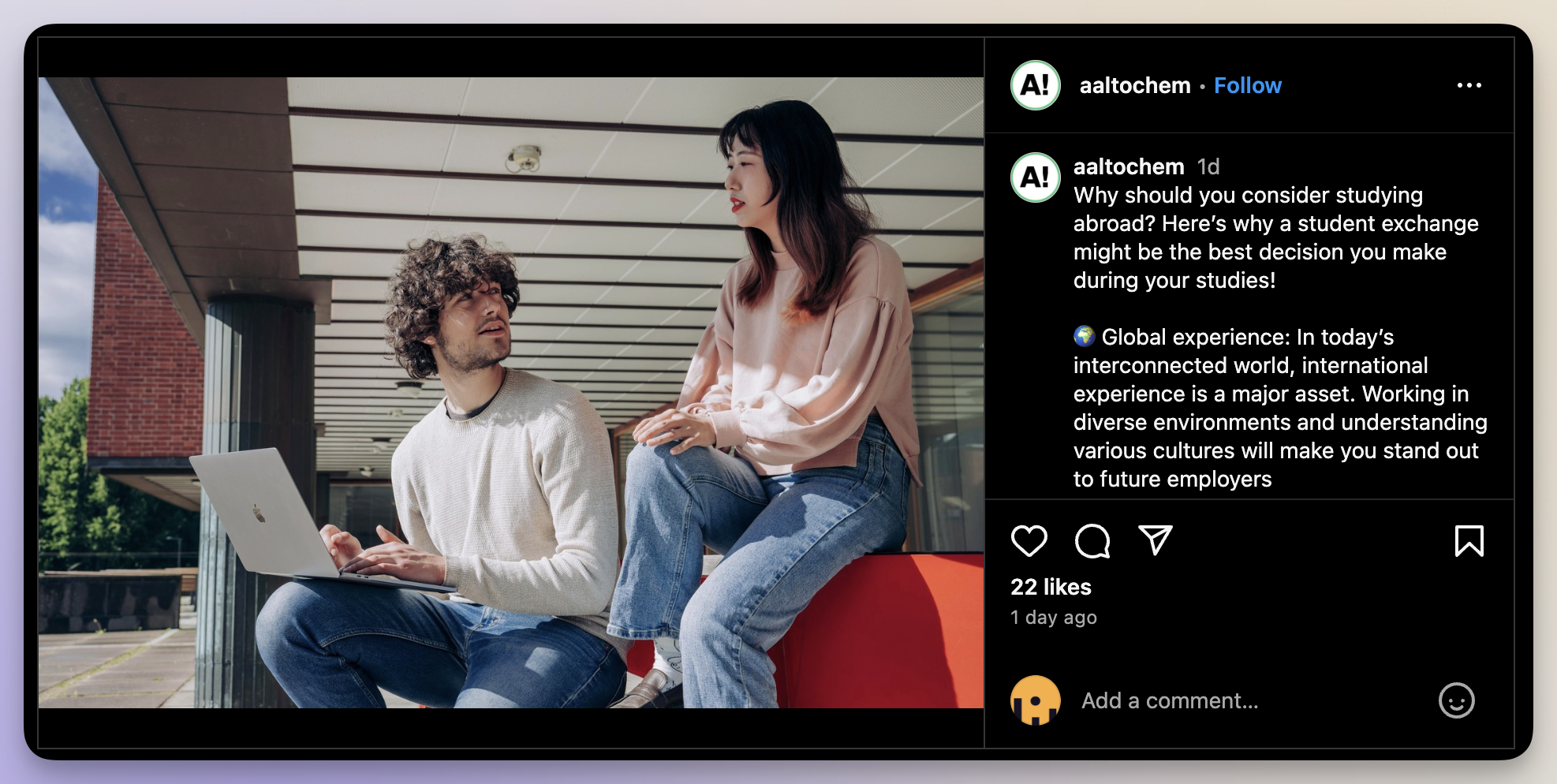
Admission & scholarships
Informing your audience about admission processes and available scholarships is key to attracting prospective students. Share clear, step-by-step guides on applying, along with details on scholarship opportunities and deadlines to help students navigate the process smoothly.
Host Q&A sessions or live chats where admissions officers answer common questions. Additionally, showcasing success stories of scholarship recipients can motivate applicants and demonstrate the financial support your institution offers.
Events & announcements
Keeping your community informed about upcoming events and important announcements is essential for maintaining engagement. Share content about academic conferences, open houses, or guest lectures, as well as key updates like new programs or policy changes.
To boost attendance and participation, create event countdowns or highlight key speakers and topics. Post-event recaps, including photos and videos, can extend the impact of these events and keep the conversation going, ensuring your audience remains connected and informed.

Social media content pillars examples for the FMCG industry — Beverages industry
The beverages sector in FMCG is highly competitive, making a strategic social media presence essential. Focusing on key content pillars as the foundation of the content strategy can help brands engage effectively, showcase products, and build strong brand loyalty.
Here are tailored content pillar examples to help you create impactful social media marketing strategies for the beverages industry.
Product highlights & new releases
Showcasing product highlights and new releases is crucial for keeping your audience informed and excited about your beverage offerings. Use high-quality visuals, such as photos and videos, to display the features and unique selling points of your products. Share behind-the-scenes content from the product development phase to build anticipation and engage your followers.
Create countdowns leading up to the release date or offering exclusive first looks to your social media audience. You can also include customer reviews or testimonials to build credibility and encourage others to try the new products.
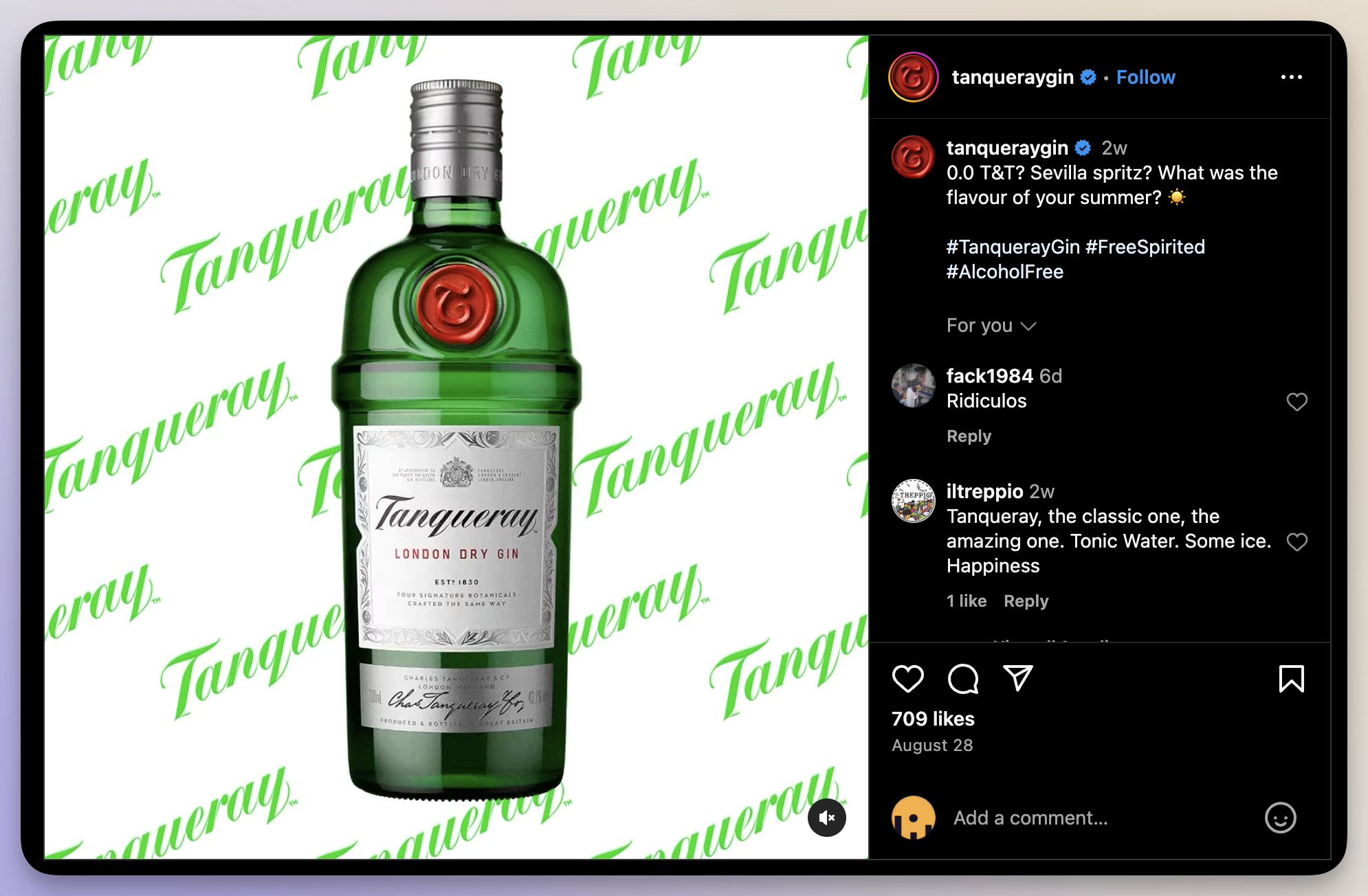
Recipe ideas & pairings
Sharing recipe ideas and drink pairings is a great way to inspire your audience and show them how to enjoy your beverages in new and creative ways. Provide step-by-step guides for creating cocktails, mocktails, or even culinary dishes that incorporate your products, appealing to both casual drinkers and culinary enthusiasts.
Collaborate with chefs or mixologists to offer professional tips. You can also encourage your audience to share their own recipes and pairing ideas, creating a community of enthusiasts who regularly interact with your brand.
Health & wellness benefits
Highlighting the health and wellness benefits of your beverages can resonate with health-conscious consumers. Share content that emphasizes natural ingredients, nutritional benefits, or functional properties like hydration or energy-boosting qualities. This positions your brand as a mindful choice for those prioritizing their well-being.
To add value, include TikTok ideas like short, engaging videos on how your beverages can be incorporated into a healthy lifestyle, such as post-workout hydration or stress relief. Infographics or quick fact videos can be effective ways to communicate these benefits clearly and concisely.

Sustainability & eco-friendly practices
Demonstrating your commitment to sustainability and eco-friendly practices can help differentiate your brand in a crowded market. Share content about your sustainable sourcing, packaging innovations, or efforts to reduce your carbon footprint. This appeals to environmentally-conscious consumers and enhances your brand’s reputation.
Create campaigns that involve them in your sustainability efforts, such as recycling programs or challenges. Highlighting partnerships with eco-friendly organizations or certifications can also add credibility and attract like-minded consumers.
Lifestyle & experience marketing
Lifestyle and experience marketing allow you to position your beverages as part of a broader, desirable lifestyle. Share content that showcases your products in various settings—be it a beach day, a party, or a relaxing evening at home. This helps your audience visualize how your beverages fit into their lives.
To make this content more relatable, use real-life scenarios and user-generated content that depicts your audience enjoying your products. Encourage followers to share their own experiences using branded hashtags, further promoting the lifestyle your brand represents.
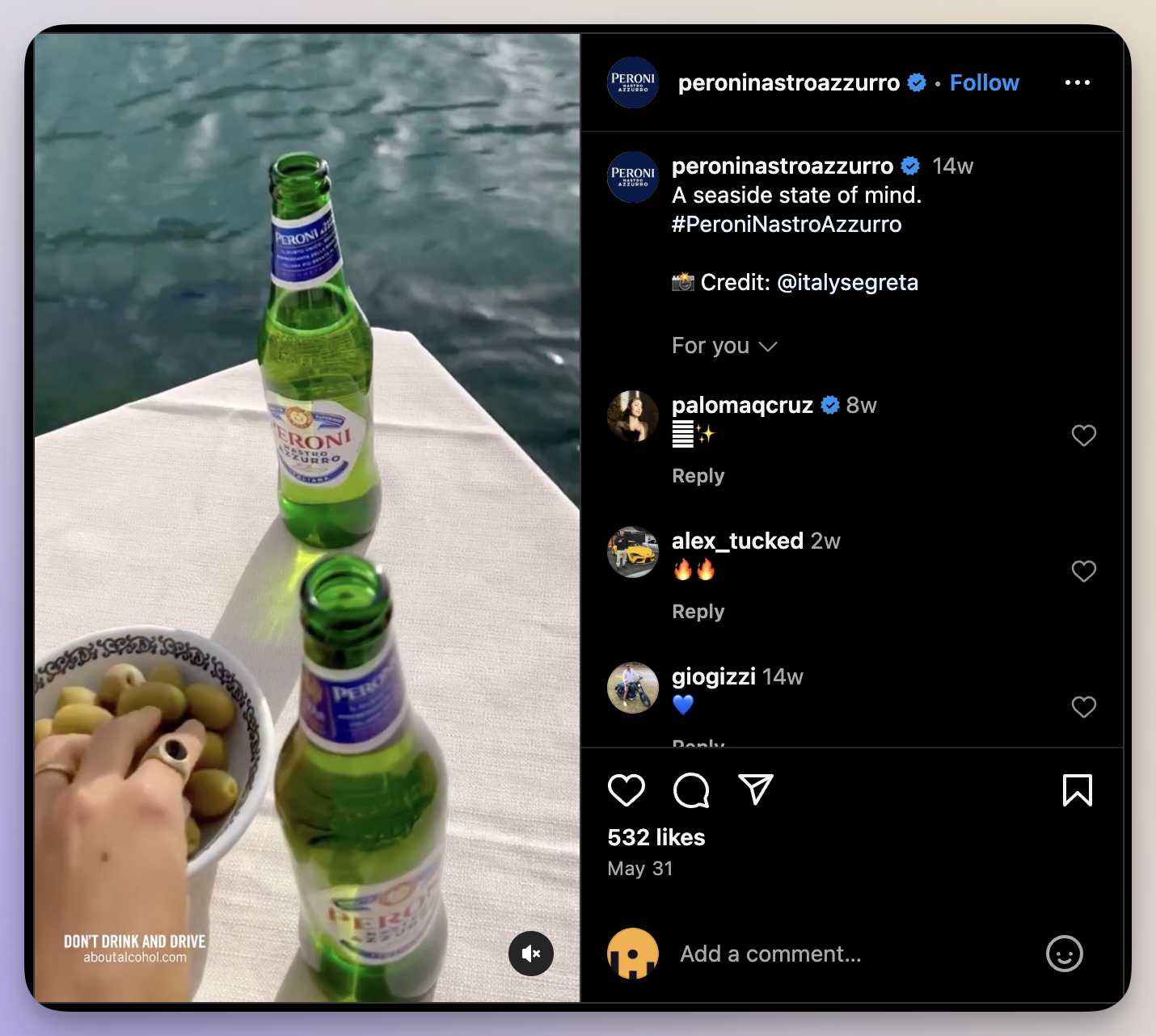
Seasonal & holiday-themed content
Seasonal and holiday-themed content is perfect for keeping your brand relevant throughout the year. Consider Reels ideas that tailor your messaging and visuals to reflect the season or upcoming holidays, offering limited-time flavors, special packaging, or themed recipes that align with the occasion.
Run seasonal contests or offer holiday discounts to encourage purchases. Creating content that aligns with the mood and festivities of the season can help your brand become part of your audience’s holiday traditions.
Influencer collaborations & partnerships
Collaborating with influencers can amplify your brand’s reach and credibility. Partner with influencers who align with your brand values and target audience, and have them showcase your beverages in their content. Whether through reviews, recipe creations, or lifestyle posts, influencer collaborations can introduce your products to new audiences.
To ensure the partnership is effective, provide influencers with creative freedom while guiding them on key messaging points. Track the performance of these collaborations to understand their impact, and consider reposting influencer content to show appreciation and build a stronger relationship.
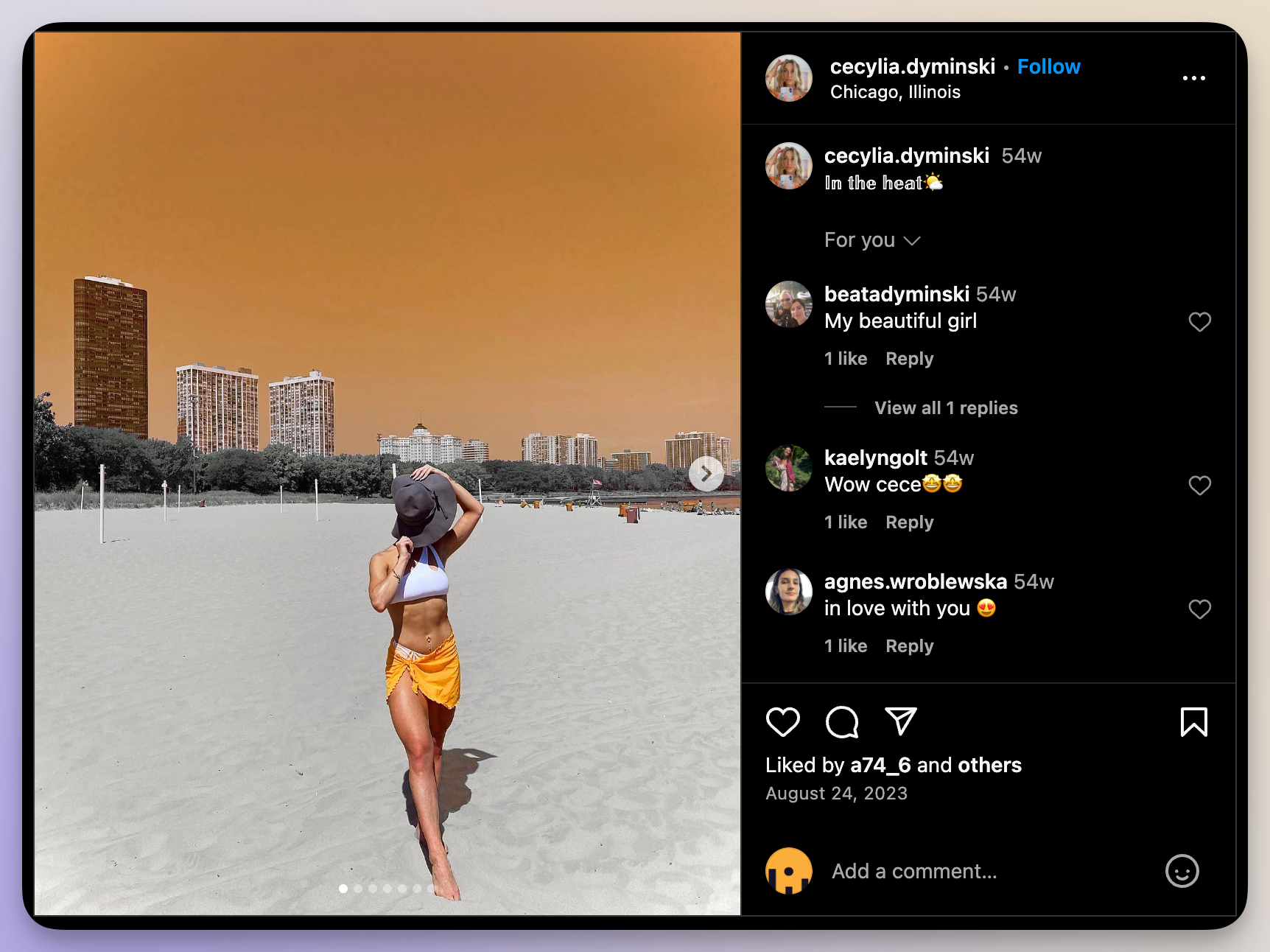
Educational content
Educational content positions your brand as an authority in the beverage industry. Share insights on topics like the production process, the origin of ingredients, or the science behind your product’s benefits. This not only informs your audience but also builds trust by showcasing your expertise.
Use formats like infographics, short videos, or behind-the-scenes tours. Hosting live Q&A sessions or webinars on related topics can also attract a more engaged and knowledgeable audience, further establishing your brand as a thought leader.
Promotions & giveaways
Promotions and giveaways are effective tactics for boosting engagement and driving sales. Announce special discounts, limited-time offers, or contests where followers can win your products. These campaigns create excitement and incentivize both new and existing customers to interact with your brand.
Encourage participants to share the giveaway with their friends or on their social media profiles. Use clear calls-to-action and simple entry requirements to ensure that as many people as possible can participate, expanding your brand’s visibility.

UGC & customer stories
User-generated content (UGC) and customer stories are powerful tools for building community and trust. Encourage your customers to share their experiences with your beverages through photos, videos, or reviews. Reposting UGC not only provides authentic content but also makes your customers feel valued and connected to your brand.
To stimulate UGC, create campaigns that invite customers to share their stories using a branded hashtag or as part of a specific challenge. When planning your campaign, consider TikTok vs Reels vs Shorts - TikTok challenges can drive viral participation, Reels can leverage Instagram’s community features, and Shorts can tap into YouTube’s diverse user base. Highlighting the most creative or heartfelt submissions on these platforms can inspire others to participate, further enriching your content and deepening customer loyalty.
Social media content pillars examples for the Health & Fitness industry
In the health and fitness industry, motivating and educating your audience is key to building a loyal following. By focusing on strategic content pillars as the foundation of the content strategy, brands can inspire healthy lifestyles, share valuable tips, and foster a strong, engaged community. Here, we explore content pillar examples tailored to help health and fitness brands create impactful social media content that resonates with their audience.
Workout & training
Share detailed workout routines and training tips to help your audience achieve their fitness goals. Whether it’s strength training, cardio, or flexibility exercises, providing structured workout plans can guide followers through their fitness journey. Include variations for different fitness levels to cater to a broader audience.
Add instructional videos or step-by-step guides that demonstrate proper techniques. You can also create themed workout series, such as “Workout Wednesdays,” to build a regular content schedule that your audience can look forward to.
Motivation & inspiration
Inspire your audience with motivational quotes, success stories, and personal challenges. Sharing stories of transformation or daily motivation can keep your followers engaged and driven to stay on track with their fitness goals. Highlighting the mental and emotional benefits of fitness can also resonate with a broader audience.
To amplify the impact, use visually compelling graphics or videos that evoke positive emotions. Encouraging your audience to share their own motivational stories or challenges can create a supportive community that fosters accountability and encouragement.

Fitness challenges & events
Organizing fitness challenges and promoting events can create a sense of community and drive engagement. Host challenges that encourage your audience to participate in daily workouts or achieve specific fitness milestones, offering rewards or recognition for participants.
To strengthen your social media community and boost participation, use social media countdowns, live updates, and hashtags to keep the momentum going. Highlighting participant progress and success stories within the community during the challenge can further motivate others to join and stay committed throughout the event.
Nutrition & healthy habits
Educate your audience on the importance of nutrition and healthy habits as part of their fitness journey.
Share meal plans, healthy recipes, and tips for balanced eating to complement their workout routines. Content that ties together diet and exercise helps followers understand the holistic approach to health.
Host Q&A sessions with nutritionists or create downloadable meal prep guides. Encouraging your audience to share their healthy recipes or meal photos can also build a community of like-minded individuals focused on health and wellness.
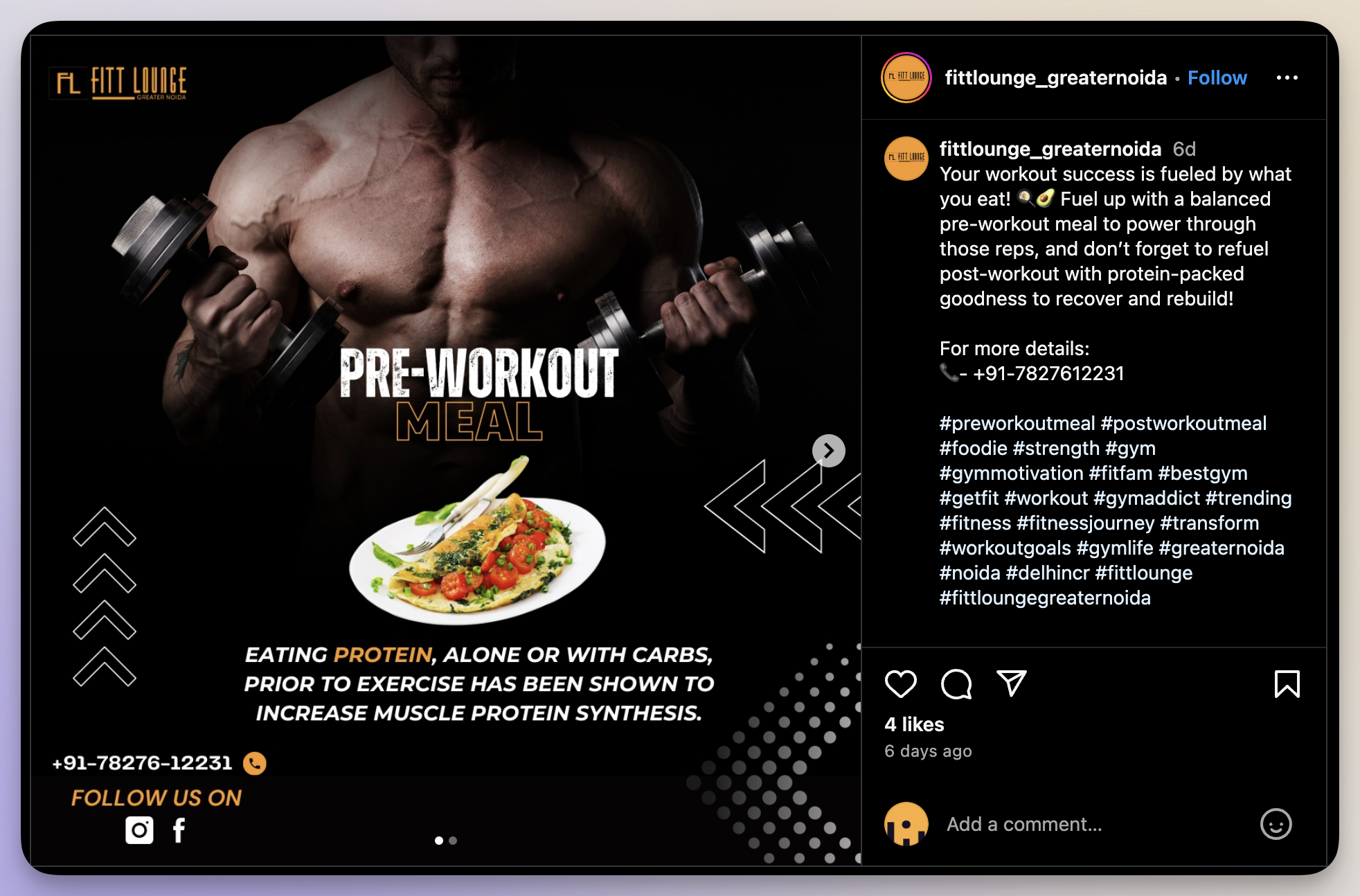
Gym tips & advice
Offer practical tips and advice for making the most of gym time, such as proper equipment usage, workout efficiency, and gym etiquette. Sharing expert tips can help both beginners and seasoned gym-goers improve their routines and avoid common mistakes.
Create short video demonstrations or infographics that provide quick, actionable advice. Encouraging followers to ask questions or share their gym tips can also foster a sense of community and continuous learning.
Fitness fashion & clothing
Highlight the latest trends in fitness fashion and clothing to keep your audience informed about what to wear for their workouts. Share content on the best gear for different types of exercise, including reviews of popular brands or product launches.
Consider collaborating with fitness apparel brands for giveaways or discount codes. Showcasing user-generated content, where followers share their workout outfits, can also create a fun, interactive environment that promotes your brand’s style and culture.

Collaborations & guest posts
Expand your content reach by collaborating with fitness influencers or hosting guest posts from industry experts. These partnerships can bring fresh perspectives to your content and introduce your brand to new audiences. Guest posts on specific topics, like advanced training techniques or wellness advice, add depth to your content offering.
Ensure that collaborations align with your brand values and target audience. Promote these partnerships across your social media platforms and encourage your audience to engage with the guest contributors, fostering a sense of community and learning.
Special offers & giveaways
Drive engagement and reward your followers with special offers and giveaways. Announce discounts on fitness programs, memberships, or gear, and organize giveaways that incentivize participation, such as sharing workout progress or tagging friends.
To increase visibility, use creative graphics and clear calls-to-action, making it easy for followers to participate. Leveraging social media algorithms by encouraging sharing and tagging can also help your content reach a wider audience, boosting your brand’s visibility and engagement.

Fitness & health trends
Stay relevant by sharing the latest fitness and health trends with your audience. Whether it’s a new workout style, a trending diet, or the latest fitness tech, keeping your followers informed helps position your brand as a thought leader in the industry.
Provide your analysis or opinion on how these trends could benefit your audience through engaging video marketing ideas like expert interviews or tutorial videos. Hosting video polls or discussions on new trends can also encourage interaction and give you insight into what your followers are interested in.
Home fitness ideas
With the growing popularity of home workouts, providing home fitness ideas can cater to a wide audience. Share content on how to set up a home gym, effective bodyweight exercises, or creative ways to stay active without equipment. This content appeals to those who prefer working out at home or have limited access to a gym.
Create video tutorials or challenge them to complete home workouts and share their progress. Highlighting user-generated content or success stories from home workouts can inspire others and build a community around your brand’s fitness philosophy.
Social media content pillars examples for the Healthcare & Pharmaceuticals industry
In the healthcare and pharmaceuticals industry, educating the public and building trust are crucial for effective social media engagement. By focusing on well-defined content pillars, brands can share essential health information, promote wellness, and connect meaningfully with their audience.
Here, we explore content pillar examples tailored to help healthcare and pharmaceutical companies create impactful, trustworthy social media content.
Health tips & wellness advice
Sharing health tips and wellness advice is crucial for educating your audience and promoting healthy lifestyles.
Provide practical, easy-to-follow tips on nutrition, exercise, and preventive care that can help your followers make informed decisions about their health.
Use clear, concise language and visual aids like infographics to make the information accessible to a broad audience.
Create a series of posts around a specific theme, such as “Wellness Wednesdays,” where you share a new tip each week. Encouraging your audience to ask questions or share their wellness tips can also foster a supportive community focused on health.

Expert interviews & educational content
Expert interviews and educational content help establish your brand as a trusted source of medical information. Feature interviews with healthcare professionals, researchers, and industry experts who can provide insights on various health topics, from chronic disease management to the latest in medical technology.
To enhance the value of this content, consider offering live Q&A sessions or webinars where your audience can interact directly with the experts. Summarizing key takeaways in easily digestible formats, like short videos or bullet points, can also help make complex information more approachable.
Patient stories & testimonials
Sharing patient stories and testimonials builds trust and humanizes your brand. Highlight personal experiences of individuals who have benefited from your healthcare services or products, showcasing the positive impact on their lives. These stories can be powerful motivators for others who may be seeking similar care.
Include photos or short videos of the patients, and consider anonymizing sensitive details to respect privacy. Encouraging patients to share their journeys on social media and tagging your brand can also help spread positive word-of-mouth and increase brand credibility.

Community health & initiatives
Highlighting community health initiatives and programs demonstrates your commitment to public health and social responsibility. Share content about free health screenings, vaccination drives, or partnerships with local organizations to improve community wellness.
Encourage your audience to participate in or volunteer for these initiatives. Use visual content, such as photos and videos, to capture the impact of these efforts and inspire others to get involved. Sharing success stories from these programs can also reinforce your brand’s dedication to making a difference.
Mental health matters
Addressing mental health is essential in today’s healthcare landscape. Share content that promotes mental well-being, offers coping strategies for stress, and educates your audience about common mental health conditions. Highlight the importance of seeking help and provide resources for those in need.
Consider featuring personal stories or interviews with mental health professionals. Creating a safe space for open discussions on mental health can also encourage your audience to engage and share their experiences, fostering a supportive online community.

Medical breakthroughs & research
Keeping your audience informed about the latest medical breakthroughs and research advancements positions your brand as a leader in the healthcare field. Share updates on new treatments, clinical trials, or innovative technologies that could impact patient care.
Make complex research more understandable by breaking down the information into key points and using visuals like charts or diagrams. Providing context on how these breakthroughs could benefit patients can also help your audience appreciate the significance of these advancements and trust your brand’s commitment to innovation.
Patient education & FAQs
Providing patient education and answering frequently asked questions (FAQs) helps demystify healthcare processes and empower your audience to take control of their health. Share content that explains common medical procedures, treatment options, and what patients can expect during their healthcare journey.
Regularly updating your FAQs based on patient inquiries can also ensure that your content remains relevant and helpful, building trust with your audience.

Company news & updates
Keeping your audience informed about company news and updates fosters transparency and trust. Share announcements about new services, partnerships, or leadership changes that reflect your brand’s growth and commitment to quality care.
Provide behind-the-scenes insights or interviews with key team members to give a more personal touch. Highlighting milestones or achievements in your company’s journey can also reinforce your brand’s reputation and engage your audience in your ongoing success.
Healthy lifestyle & myths
Educating your audience about healthy lifestyles and debunking common health myths helps build credibility and trust. Share content that promotes balanced diets, regular exercise, and preventive healthcare while correcting misconceptions about health and wellness.
Create a myth-busting series where you address one common misconception in each post. Providing evidence-based information and encouraging followers to ask questions or share their experiences can also make your content more interactive and informative.

Health campaigns & awareness events
Participating in health campaigns and awareness events allows your brand to support important causes and engage with your community. Share content about upcoming health observances, such as World Health Day or Breast Cancer Awareness Month, and highlight your brand’s involvement in these initiatives.
Create dedicated campaigns with specific hashtags and encourage your audience to share their stories or show support. Offering educational content, resources, or even virtual events tied to these awareness days can further amplify your brand’s impact and connect you with a broader audience.
Final thoughts
As you’ve seen throughout this article, social media content pillars are essential for structuring and guiding your social media strategy. They help maintain consistency, relevance, and alignment with your brand goals, even as digital trends shift. By implementing content pillars effectively, you can create content that resonates with your audience and drives engagement across your social media channels.
Socialinsider’s AI analysis tools offer a powerful way to refine and optimize your approach, providing actionable insights to ensure that your content strategy remains effective and adaptable. With these tools, you can continuously monitor and enhance your content pillars, leading to sustained growth and success in your social media efforts.
FAQs about social media content pillars
1. What are content pillars for social media?
Social media content pillars are the core themes or topics that form the foundation of your brand’s social media content strategy. These are the main categories that you consistently focus on in your posts, ensuring your messaging is organized, on-brand, and aligned with your audience’s interests and your business goals.
Each content pillar represents a key area your brand wants to be known for and where you can consistently deliver value. For example, a fitness brand might use pillars like workout tutorials, nutrition tips, customer transformations, motivational content, and product highlights. These pillars help ensure your content is varied yet cohesive, making your brand recognizable and trustworthy across platforms.
Content pillars are also called content buckets or categories, and they help structure your content calendar, guide content creation, and maintain a consistent brand voice.
2. How to create content pillars for social media
1. Define your brand’s mission and goals
Start by clarifying what you want to achieve on social media (e.g., brand awareness, engagement, sales, thought leadership). Your content pillars should directly support these objectives.
2. Understand your audience
Research your target audience’s demographics, interests, pain points, and behaviors. Use social listening, surveys, and analytics to identify what resonates with them.
3. Analyze competitors
Study competitors’ content to spot gaps, opportunities, and successful themes.
4. Brainstorm and group themes
List potential topics that align with your brand’s values and your audience’s needs. Group similar ideas into broad categories—these become your pillars.
5. Choose 3–5 core pillars
Select three to five main categories that are broad enough to allow for variety but focused enough to maintain consistency.
6. Define subtopics and content formats
For each pillar, identify subtopics or “buckets” to further organize your ideas (e.g., under “nutrition,” you might have recipes, meal plans, and tips).
Plan different content formats for each pillar (videos, infographics, stories, etc.).
7. Map content to pillars and build a calendar
Assign each content idea to a pillar and plan your posts in a content calendar to ensure a balanced mix.
8. Track performance and optimize
Monitor analytics to see which pillars and topics perform best, and adjust your strategy as needed.







